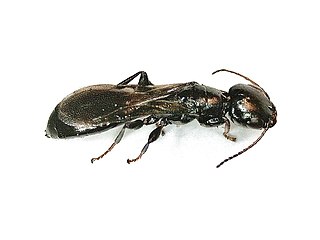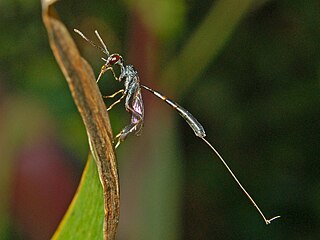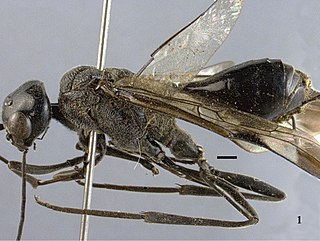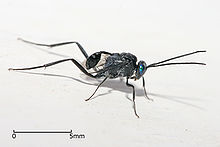
An instar is a developmental stage of arthropods, such as insects, which occurs between each moult (ecdysis) until sexual maturity is reached. Arthropods must shed the exoskeleton in order to grow or assume a new form. Differences between instars can often be seen in altered body proportions, colors, patterns, changes in the number of body segments or head width. After shedding their exoskeleton (moulting), the juvenile arthropods continue in their life cycle until they either pupate or moult again. The instar period of growth is fixed; however, in some insects, like the salvinia stem-borer moth, the number of instars depends on early larval nutrition. Some arthropods can continue to moult after sexual maturity, but the stages between these subsequent moults are generally not called instars.

Cryptinae is a subfamily of wasps in the family Ichneumonidae. The family has also been called Gelinae, Hemitelinae, and Phygadeuontinae by various authorities, though the Phygadeuontinae have since been elevated to a separate subfamily.

Evaniidae is a family of parasitoid wasps also known as ensign wasps, nightshade wasps, hatchet wasps, or cockroach egg parasitoid wasps. They number around 20 extant genera containing over 400 described species, and are found all over the world except in the polar regions. The larvae of these solitary wasps are parasitoids that feed on cockroaches and develop inside the egg-cases, or oothecae, of their hosts.

Ancistrocerus is a widely distributed genus of potter wasps present in many biogeographical regions of the world. They are nonpetiolate eumenine wasps with a transverse ridge at the bending summit of the first metasomal tergum and with a low and opaque propodeal lamella completely fused to the submarginal carina.

Agathidinae is a subfamily of braconid parasitoid wasps. Some species have been used in biological control programs.

The Doryctinae or doryctine wasps are a large subfamily of parasitoid wasps within the family Braconidae.

The Bethylidae are a family of aculeate wasps in the superfamily Chrysidoidea. As a family, their biology ranges between parasitoid wasps and hunting wasps.

Evania appendigaster, also known as the blue-eyed ensign wasp, is a species of wasp in the family Evaniidae. Its native range is not known, but it likely originated in Asia. Today it occurs throughout the tropics and subtropics and in many temperate regions. As with the rest of its family, the blue-eyed ensign wasp is a parasitoid known for specializing on cockroach eggs.

The Rogadinae are a large subfamily of braconid parasitoid wasps. Several Rogadinae species parasitize pest caterpillars and are important for naturally occurring biological control.

Leucospis is a genus of wasps belonging to the family Leucospidae. Most species are brightly coloured with yellow and black patterning and about 2 cm long. They have characteristically enlarged femurs on the hind leg, with the lower margin toothed. The wings have a longitudinal fold and the long ovipositor is bent over their backs above the abdomen or metasoma. They are parasitic on wasps and solitary bees that construct cells and provision food for their offspring. The Leucospis larvae live and grow as ectoparasites of the host larvae. Usually, only one parasite emerges from a single cell. The genus Micrapion from South Africa is very closely related, and phylogenetic studies suggest merging of the two genera. The genus Leucospis is found across the world in the tropical regions.

Gasteruption is a genus of wasps belonging to the family Gasteruptiidae subfamily Gasteruptiinae.

Hyptia is a genus of ensign wasps in the family Evaniidae. There are at least 50 described species in Hyptia. Most Hyptia can be differentiated from other genera by heavily reduced venation of the forewings, wherein only one closed cell is present.
Evaniella is a genus of ensign wasps in the family Evaniidae. There are more than 70 described species in Evaniella.

Aulacus is a genus of aulacids, ensigns, and gasteruptiids in the family Aulacidae. There are 77 species of Aulacus.

Dusona is a genus of parasitoid wasps belonging to the family Ichneumonidae. It is the most species rich genus of the subfamily Campopleginae with 442 known species.














